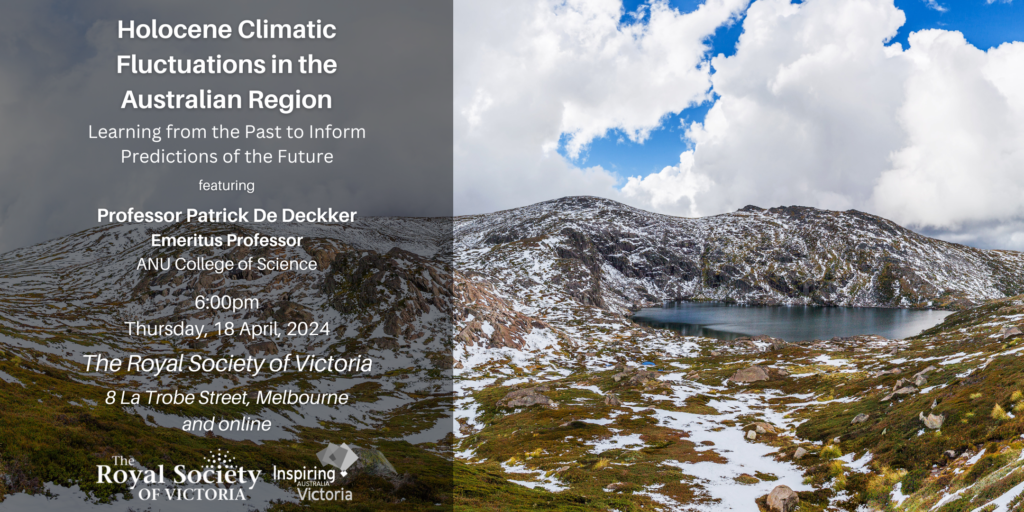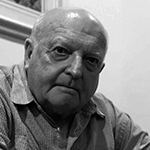Holocene Climatic Fluctuations in the Australian Region

In the last Ice Age, Australia endured very dry conditions and sea levels were up to 125m lower compared to today. Since then, life on Earth has enjoyed ~12,000 years of the more accommodating climatic conditions of the Holocene. This comfortable epoch has nonetheless demonstrated significant variability due to interactions between the major drivers of the Earth’s climate system.
As the dominant mode of variability in the southern hemisphere, the Southern Annular Mode (SAM) exerts influence on rainfall and temperature in Australia, driven by the behaviour of powerful westerly winds that circumnavigate the southernmost third of the globe and drive the Antarctic Circumpolar Current around Antarctica. A close examination of key, well-dated Holocene sites in the Australian region, both on land and at sea, indicate that at the very beginning of the Holocene, the region was locked into a continuous positive SAM as a result of strong westerlies. After that period, the entire region switched to a negative SAM scenario and the westerlies must have retreated further south of Australia.

Afterwards, for a period spanning ~8,200 to ~5,500 years ago, temperatures were higher than today, including in the oceans. Lake levels and postulated rainfall were extraordinarily high, and vegetation spectra were very different to today in many places. In contrast, air temperatures recognised in Antarctic ice cores are at the opposite to those recognised in Australia, and atmospheric CO2 levels were at their lowest for the entire Holocene. We refer to this period as the Holocene Hypsithermal.
Climatic conditions then progressively deteriorated everywhere, a little after ~6,000 years BP until recent times, as El Niño-Southern Oscillation signals with alternating El Niño and La Niña conditions were established across the entire Pacific region.
Join acclaimed palaeontologist Professor Patrick De Deckker, who will illustrate how human activities in southeastern Australia changed well after the Hypsithermal, with more sedentary activities along the major rivers and an enhancement of food production in organised settings suggestive of villages, in stark contrast with human migrations across North Africa during the Holocene.
About the Speaker
 Professor Patrick De Deckker AM FAA is an Emeritus Professor based at the ANU College of Science. Patrick pioneered the study of the Quaternary (last 2 million years) history of the oceans bordering Australia and has principally used microfossils and their chemical composition to reconstruct past changes. He was also first to link patterns of environmental change on land (through salt lake records) and at sea, again using microfossils and other proxies. He has found that during the Holocene, the oceans have become progressively warmer. His most recent innovative research deals with the microbiological and geochemical fingerprinting of airborne dust with the aim at linking dust events with changes in the oceans.
Professor Patrick De Deckker AM FAA is an Emeritus Professor based at the ANU College of Science. Patrick pioneered the study of the Quaternary (last 2 million years) history of the oceans bordering Australia and has principally used microfossils and their chemical composition to reconstruct past changes. He was also first to link patterns of environmental change on land (through salt lake records) and at sea, again using microfossils and other proxies. He has found that during the Holocene, the oceans have become progressively warmer. His most recent innovative research deals with the microbiological and geochemical fingerprinting of airborne dust with the aim at linking dust events with changes in the oceans.
Patrick completed his PhD in the Department of Zoology at the University of Adelaide on salt lakes, their biota and Quaternary lacustrine deposits, a field he continued during postdoctoral positions. He obtained a DSc from the same university, this time from the Department of Geology and Geophysics, for long-term accomplishment in the fields of limnology, palaeolimnology, palaeoceanography and micropalaeontology. In 1998, Patrick joined the Australian National University and held a full-time teaching position combined with research up until his recent retirement.
During his entire career, Patrick’s work has always been multidisciplinary in nature with a common aim: to obtain information of relevance for the reconstruction of past marine and continental environments of importance for the understanding of global and regional climatic variability. In recognition of his efforts and achievements, he has been awarded the Verco Medal (1992), the Australian Society for Limnology Medal (2005), the Christoffel Plantin Medal (2008), the Mawson Medal (2010) and the Brady Medal (2019). In 2007, he was appointed a Member of the Order of Australia (AM) for his research and teaching efforts, and an Officer of the Order of Leopold II by the Kingdom of Belgium (2018) for outstanding achievements in science. Patrick is also a Fellow of the Australian Academy of Science.
Professor Patrick De Deckker AM, FAA is the 2023 recipient of the Royal Society of Victoria’s Medal for Excellence in Scientific Research in Category III: Earth Sciences. Patrick will be awarded the RSV Medal following the lecture.








